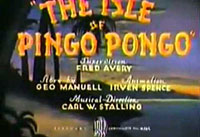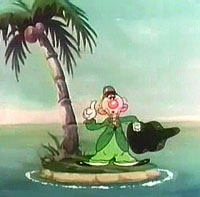
The sixth cartoon of the Censored Eleven is the “Merrie Melodies” episode The Isle of Pingo Pongo, which Warner Brothers released in 1938. It is a blend of the old and the new and in more ways than one. Concerning the “old,” the film is the second on the list that Tex Avery directed, and it is the second of the Eleven to eventually be a “Blue Ribbon” reissue.
 It also relies on characterizations of African American jazz musicians (as in Clean Pastures) and indigenous Africans (as in Jungle Jitters). What is new about the film is that it blends the ethnic generalizations so that the natives act like jazz musicians. Also, in contrast to earlier cartoons having some spot-gags before introducing the plot, this cartoon is all spot-gags. Finally, the majority of the film’s length does not feature any ethnic caricatures. The indigenous residents of Pingo Pongo collectively take up barely half of the film’s duration; moreover, they appear in the latter half of the cartoon.
It also relies on characterizations of African American jazz musicians (as in Clean Pastures) and indigenous Africans (as in Jungle Jitters). What is new about the film is that it blends the ethnic generalizations so that the natives act like jazz musicians. Also, in contrast to earlier cartoons having some spot-gags before introducing the plot, this cartoon is all spot-gags. Finally, the majority of the film’s length does not feature any ethnic caricatures. The indigenous residents of Pingo Pongo collectively take up barely half of the film’s duration; moreover, they appear in the latter half of the cartoon.
 Warner Brothers considered the film worthy of a second release in the 1940s. It had box-office value as a Technicolor cartoon. Also, its parody of travel documentaries was still timely when reissued, and the images of the dark-skinned characters were still on a par with Hollywood’s portrayals of people of African heritage. In addition, as discussed for the Censored Eleven cartoon Jungle Jitters, much of the African continent remained colonized by European countries during and immediately after World War II.
Warner Brothers considered the film worthy of a second release in the 1940s. It had box-office value as a Technicolor cartoon. Also, its parody of travel documentaries was still timely when reissued, and the images of the dark-skinned characters were still on a par with Hollywood’s portrayals of people of African heritage. In addition, as discussed for the Censored Eleven cartoon Jungle Jitters, much of the African continent remained colonized by European countries during and immediately after World War II.
 When Associated Artists Productions and then United Artists brought the cartoon to television through syndication in the late 1950s, its imagery was no different from other syndicated fare that had once run in theaters. But by 1968, Europe had started to decolonize Africa, and the sight-gags about the lip sizes of dark-skinned figures and the “primitive” behavior of the indigenous hinted at the colonialism from which the continent had started breaking free. Ultimately, United Artists decided not to censor just the latter half of the film and keep it in circulation; instead, it removed the entire film on the basis of the ethnic images in four of the cartoon’s eight minutes. That, too, was new for a Censored Eleven film.
When Associated Artists Productions and then United Artists brought the cartoon to television through syndication in the late 1950s, its imagery was no different from other syndicated fare that had once run in theaters. But by 1968, Europe had started to decolonize Africa, and the sight-gags about the lip sizes of dark-skinned figures and the “primitive” behavior of the indigenous hinted at the colonialism from which the continent had started breaking free. Ultimately, United Artists decided not to censor just the latter half of the film and keep it in circulation; instead, it removed the entire film on the basis of the ethnic images in four of the cartoon’s eight minutes. That, too, was new for a Censored Eleven film.
And now we are over the halfway point with the columns about the Censored Eleven.


 Christopher P. Lehman is a professor of ethnic studies at St. Cloud State University in St. Cloud, Minnesota. His books include American Animated Cartoons of the Vietnam Era and The Colored Cartoon, and he has been a visiting fellow at Harvard University.
Christopher P. Lehman is a professor of ethnic studies at St. Cloud State University in St. Cloud, Minnesota. His books include American Animated Cartoons of the Vietnam Era and The Colored Cartoon, and he has been a visiting fellow at Harvard University.



























Original (special?) opening titles: https://www.youtube.com/watch?v=yC2acO74B-c
Fan re-creation. Since when was the title card shown while the theme was still playing?
Nice re-creation, though that Bruce narration sounds legit (and you can faintly hear the opening cue under it)..
Uh, no, it’s not a recreation. That’s the authentic original opening. Where would a fan have gotten that bit of narration that’s not in the reissue?
My question is, who’s the source?
When the original titles first surfaced on YouTube about ten years ago, I asked the uploader how he/she acquired it. He/she claimed that they transferred it to vhs from a 35mm print that someone at Technicolor owned some 30 years prior.
Interesting they chose to open the cartoon that way with the usual theme running through the cartoon’s title/credits.
Try this one without subtitles http://www.dailymotion.com/video/x60yxpt
Ultimately, United Artists decided not to censor just the latter half of the film and keep it in circulation
At least one cartoon, SEPTEMBER IN THE RAIN, got to remain in circulation in abridged form. The Fats Waller-Louis Armstrong and the Al Jolson sequences were removed from the cartoon.
I had seen the short version of SEPTEMBER IN THE RAIN and had always figured the cuts were made on a local station level, but after I acquired a 16mm print of the cartoon and examined it, I found it to be absolutely splice-free where the offending scenes would have been taken out, indicating that the edits were built into the print.
Don’t know if that happened to any other pre-48s.
I always thought UA could have kept the short in circulation with the stereotypes removed the same way SEPTEMBER IN THE RAIN and the Disney cartoon SPARE THE ROD were edited for television. Although I never thought of the decolonization of Africa as a factor.
As a spot gag cartoon, Tex did a lot better with DETOURING AMERICA and CROSS COUNTRY DETOURS. He was clever with the deliberate geographic errors. I do like the bandleaders lively rendition of Sweet Georgia Brown though.
Some animation was reused in AFRICA SQUEAKS, another rarely seen short.
One of few Censored 11 shorts that I think (to an extent) is worth a look, as it does have some great gags (ones that don’t rely on African native stereotyping though). One gag that I’ve always found humorous (even if you can kinda telegraph the joke a mile away), is the one with the native who whips out a camera and takes a picture of the audience after the narrator mentions he’s not aware of our presence.
Also the random sports footage (“How’d this get here? Oh, well….”)
I wonder why Egghead talks like Porky Pig in this short.
As well pointed out in the review above, this is a parody of vintage travelogues. The one offensive aspect is the blackface design of the characters, complete with huge lips. It is hard to excuse all of that today. However, if you can get past that, there is an obvious wide-eyed innocence to this short because the animation staff wasn’t thinking as much about race (except on a subconscious level) as they were stock documentary narration tactics. Of course, AFRICA SPEAKS is constantly referenced in too many cartoons of the thirties to count, but it was a colossal documentary hit much like NANOOK OF THE NORTH. Maybe it is just me, but I view these much like the Uncle Tom’s Cabin spoofs that were all about an over-performed play that practically every moviegoers then was familiar with. Note here how only the musical performers speak in “jive” talk, but so many other characters go against the racial stereotypes such as the native yanking out his camera like a tourist and another group singing country hillbilly. Likewise, Tex Avery repeated the deer carrying a dead human gag with a Caucasian in FIELD AND SCREAM.
This one ranks pretty high on the offensiveness scale. Pingo Pongo’s supposed to be a Pacific island, to judge by the Polynesian prints the “Comin’ Round the Mountain” singers are wearing, and there’s that Hawaiian guitar at the end. But it’s big-lipped ‘darkies’ all the same. I’m sure the attitude in the story room was Natives is Natives, what’s the difference? Interestingly, they throw in a brief shot of more-realistic dancing girls; those “seven dusky beauties” you might have seen advertised at a Harlem floor show (for whites only, natch).
That is why I coyly stated “on a subconscious level” in parenthesis. The racism was regrettably always there, just as it was always there even before politicians and a major leader (and I won’t name names to make this discussion all “partisan”) more recently made it OK for many Americans to be more articulate about it. It also didn’t get any better as the years progressed, from George Pal’s HOOLA BOOLA through Chuck Jones’ BOYHOOD DAZE (despite the masks covering the faces in the slightly more sensitive fifties).
Pretty sure if you added footage from Crazy Cruise and Wacky Wildlife, You could replace all the racist stuff and have a 6-7 minute cartoon
Plus even if you cut the final part, it would make sense and be better to follow than other poorly edited cartoons